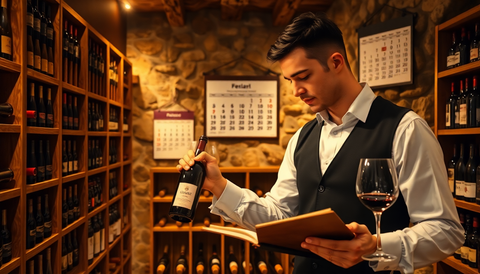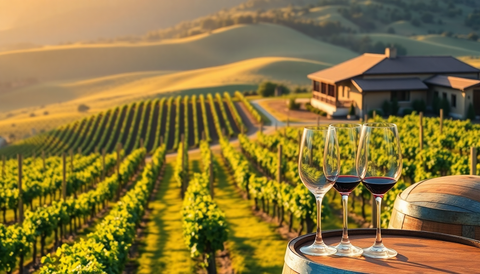As the owner of McLaren Vale Cellars, I've had the privilege of helping countless wine enthusiasts discover the joys of fine wine. Over the years, I've noticed that many people feel intimidated by the process of selecting and purchasing wine. They worry about making the "wrong" choice or not knowing enough to shop like a true connoisseur.
Well, I'm here to tell you that buying wine like a sommelier is not as daunting as it may seem. With a few key tips and a bit of knowledge, anyone can develop the confidence to navigate the world of wine and find bottles that perfectly suit their tastes and occasions. In this comprehensive guide, I'll share the insider secrets that will have you shopping for wine like a pro in no time.
Understanding Wine Regions and Varietals
The first step to buying wine like a sommelier is to familiarize yourself with the major wine regions and grape varietals. This knowledge will not only help you make more informed choices, but it will also allow you to explore new and exciting wines that you may have overlooked in the past.
Exploring the Renowned Regions of the World
When it comes to wine, certain regions have earned a reputation for producing exceptional quality. Some of the most renowned wine regions include:
- Bordeaux, France: Known for its world-class red blends made from Cabernet Sauvignon, Merlot, and other Bordeaux grapes.
- Napa Valley, California: A premier destination for bold, fruit-forward Cabernet Sauvignons and other classic American varietals.
- Tuscany, Italy: Famed for its elegant, age-worthy Sangiovese-based red wines, such as Chianti and Brunello di Montalcino.
- Marlborough, New Zealand: Renowned for its crisp, aromatic Sauvignon Blanc.
- Rioja, Spain: Home to complex, oak-aged red wines made primarily from the Tempranillo grape.
By understanding the unique characteristics and specialties of these and other renowned wine regions, you'll be better equipped to navigate the vast world of wine and make informed purchasing decisions.
Mastering the Major Grape Varietals
In addition to familiarizing yourself with wine regions, it's also important to have a solid understanding of the major grape varietals. Some of the most popular and widely recognized include:
- Cabernet Sauvignon: A full-bodied red wine known for its bold flavors of black fruit, oak, and tannins.
- Chardonnay: A versatile white wine that can range from crisp and unoaked to rich and creamy, depending on the winemaking style.
- Pinot Noir: A light-to-medium-bodied red wine with delicate flavors of red fruit, earth, and subtle spice.
- Sauvignon Blanc: A refreshing white wine with bright acidity and flavors of citrus, herbs, and sometimes tropical fruit.
- Merlot: A smooth, approachable red wine with flavors of plum, black cherry, and soft tannins.
By familiarizing yourself with these and other major grape varietals, you'll be able to better understand the flavor profiles and characteristics of the wines you encounter, making it easier to select bottles that align with your personal preferences.
Developing Your Palate and Tasting Technique
Once you've built a solid foundation of knowledge about wine regions and grape varietals, the next step to buying wine like a sommelier is to develop your palate and tasting technique. This will not only help you identify the flavors and aromas you enjoy, but it will also give you the confidence to make more informed purchasing decisions.
Exploring the Art of Wine Tasting
Wine tasting is a skill that takes time and practice to develop, but it's well worth the effort. When tasting wine, focus on the following key elements:
- Appearance: Observe the color, clarity, and viscosity of the wine in the glass.
- Aroma: Swirl the wine and take a deep inhale to identify the various aromas and bouquet.
- Taste: Take a sip and pay attention to the wine's flavors, acidity, tannins, and overall balance.
- Finish: Note how long the flavors linger on your palate after swallowing the wine.
By regularly tasting a variety of wines and taking the time to analyze each element, you'll gradually develop a more discerning palate and a better understanding of the characteristics you enjoy most.
Keeping a Wine Journal
One of the best ways to track your tasting experiences and refine your palate is to keep a wine journal. In your journal, record your thoughts and impressions of each wine you taste, including:
- The wine's name, vintage, and region
- The grape varietals used
- Your overall impression of the wine's appearance, aroma, taste, and finish
- Any specific flavors or aromas you detected
- Your personal rating or score for the wine
Maintaining a wine journal will not only help you remember the wines you've tried, but it will also allow you to identify patterns in your preferences and discover new varietals or regions that you may want to explore further.
Navigating the Wine Shop Like a Pro
With a solid foundation of wine knowledge and a well-developed palate, you're now ready to tackle the wine shop like a seasoned sommelier. Here are some expert tips to help you navigate the aisles and find the perfect bottles for any occasion.
Communicating with the Staff
Don't be afraid to engage with the knowledgeable staff at your local wine shop. They can be an invaluable resource, offering recommendations, insights, and guidance to help you find the right wines for your needs. When speaking with the staff, be sure to:
- Describe your personal taste preferences and the types of wines you typically enjoy.
- Provide information about the occasion or meal you're shopping for, as this will help the staff make more tailored recommendations.
- Ask for suggestions on new or lesser-known wines that you might not have tried before.
- Inquire about any special offers, sales, or featured wines that the shop has highlighted.
By building a rapport with the staff and being open to their expertise, you'll be able to discover new and exciting wines that you may have overlooked on your own.
Exploring the Shop's Layout and Organization
Most well-curated wine shops will organize their inventory in a way that makes it easy for customers to navigate. Pay attention to the shop's layout and organization, as this can provide valuable clues about the wines available. Look for sections or displays dedicated to:
- Specific wine regions (e.g., Napa Valley, Bordeaux, Tuscany)
- Grape varietals (e.g., Cabernet Sauvignon, Chardonnay, Pinot Noir)
- Price points (e.g., budget-friendly, mid-range, premium)
- Unique or limited-production offerings
- Food-friendly wines or wines for special occasions
By familiarizing yourself with the shop's organization, you'll be able to quickly identify the areas that align with your interests and preferences, making your shopping experience more efficient and enjoyable.
Leveraging Online Resources
In addition to the expertise of the in-store staff, you can also take advantage of online resources to help guide your wine purchasing decisions. Many reputable wine shops and publications offer:
- Detailed tasting notes and reviews for a wide range of wines
- Recommendations for food pairings and occasion-specific wine selections
- Information on the latest trends, vintages, and releases in the wine world
- Virtual wine tastings and educational content to expand your knowledge
By combining the insights from online resources with the personalized guidance of the in-store staff, you'll be well on your way to shopping for wine like a true sommelier.
Putting It All Together: Selecting the Perfect Bottle
With your newfound wine knowledge and shopping techniques, you're now ready to put it all together and select the perfect bottle (or bottles) for any occasion. Whether you're looking for a special-occasion wine, a weeknight dinner pairing, or a thoughtful gift, here are some final tips to help you make the best choice:
- Consider the occasion and the food you'll be serving. Choose wines that will complement the flavors and textures of your meal.
- Seek out unique or limited-production offerings that will impress your guests and provide a memorable tasting experience.
- Don't be afraid to experiment with new grape varietals or regions that you haven't tried before. You might just discover a new favorite.
- When in doubt, consult the knowledgeable staff at your local wine shop. They can provide invaluable guidance and recommendations tailored to your specific needs.
- Remember that the "best" wine is ultimately the one that you personally enjoy the most. Trust your palate and don't be swayed by scores or ratings alone.
By following these expert tips and embracing the joy of wine exploration, you'll be well on your way to shopping for wine like a seasoned sommelier. So, the next time you step into a wine shop, approach it with confidence, curiosity, and a willingness to discover new and exciting vintages that will delight your senses and elevate any occasion.
Happy shopping!




Comments (0)
There are no comments for this article. Be the first one to leave a message!